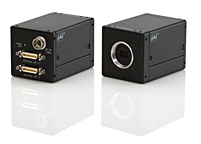|
||||||||||||||||||||||||||||||||||||||||||
|
||||||||||||||||||||||||||||||||||||||||||
| AD-081GE Go to Jai Cameras Go to High Resolution Monochrome Cameras Go to GigE Cameras Go to 2CCD cameras |
 |
Providing more than twice the high-dymanic range of normal cameras, operating in the visible spectrum and designed around 2CCD monochrome, progressive scan, prism-mounted sensors, the AD-081GE leverages the benefits of GigE Vision/GeniCam technology by adding innovative capabilities and improvements previously unavailable in their the CameraLink version of this camera.
Special benefits of 2CCD design
The prism-based design enables a single optical
path to be split across both CCDs simultaneously while maintaining alignment
to within one-quarter pixel.
By independently adjusting the shutter/gain settings on each of the two
CCDs and fusing the two synchronized video streams (using the new S/N
mode), the AD-081GE is able to capture details in scenes with
a wide variation of light intensities, providing more
than double the dynamic range of standard CCD cameras (up to
~120 dB) but in a linear fashion that avoids
the noise, shutter, and compression issues found in typical CMOS-based
logarithmic or LinLog™ high dynamic range cameras.
Alternatively, the timing of each CCD’s readout can be offset by one-half frame and interleaved together to produce 60 fps output without the image degradation that would result from over-clocking the CCDs.
Other
features
Selection of capture modes
The AD-081GE is equipped with continuous mode, pre-select trigger mode,
pulse width trigger mode and a special 3-shot PIV (Particle Image Velocimetry
see below) mode.
Output
Output is via a standard GigE Vision interface, which
can be used in a one-cable or two-cable configuration, depending on the
mode used.
GigE Vision, GeniCam
and the JAI SDK software combination
Combining the above three facilities allows for a built-in image fusion
routines that can automatically produce high-dynamic range output without
any post-processing required. The camera uses built-in algorithms to fuse
the two images and outputs the combined result.
Specialised HDR functions
Understanding that users may have unique requirements, JAI has added a
variety of specialized HDR functions allowing users to offload HDR processing
to a host computer and build customise applications to fit their own needs.
Linear Output
Many CMOS HDR cameras use logarithmic methods to compress 16- or 20-bit
scene information into 8- or 10-bit pixel data on the sensor. However,
this allows the high-dynamic range scenes to be displayed at the expense
of losing the true values of the 20-bit pixel scale. By using two CDs,
the camera is able to capture a linear representation of true 20-bit pixel
values for machine-vision processing while converting those values in
a way that can be displayed on standard monitors.
The camera's prism-based design guarantees alignment of the two CCDs to within a quarter pixel accuracy, enabling a full 30 fps HDR performance with no ghosting or parallax issues on moving objects.
Better analysis of ultra-fast events
Unique "3-frame" *Particle Image Velocimetry (PIV) trigger modes leverage the camera's two-channel design to capture three closely-spaced images on a single trigger instead of the two captured by conventional PIV trigger modes. This allows 50% more data to provide better analysis of ultra-fast events.
Read more: Adept Machine Vision Techology Newsletter - July, 2010.
Typical applications for the
Jai AD-081GE
Typical HDR applications for the AD-081GE include
inspection tasks where incident light or bright reflections are present,
such as LED inspection, welding, and various types of lighting or glass
inspections.
The camera is also ideal for a wide range of automotive applications,
microscopy, or high-end surveillance uses. The parameters of each CCD
can be adjusted by the user to provide maximum dynamic range or maximum
contrast/sensitivity within a narrower lighting range, depending on the
application.
| Model | AD-081GE |
| Sensor | Two 1/3” Monochrome IT CCD mounted on an optical prism |
| Resolution | 1024 (h) x 768 (v) active pixels per channel |
| Pixel Size | 4.65 x 4.65µm |
| Video Output | Dual monochrome 8-, 10- or 12-bit GigE Vision output. Sunchronised or separate timing. |
| Max. Line / Frame Rate | 30 frames/second (HDR) image fusion; 60 frames/second (interleaved) |
| Shutter | Auto shutter from 1/30 to 1/10,000 sec. |
| Lens Mount | C-mount (use 3CCD type, Max. 4.0 mm thread) |
| Operating temperature | -5°C to +45°C |
| Power | 12V - 24V DC ± 10%. |
| Dimensions | 55 (H) x 55 (W) x 98.3 (D)mm |
| Weight | 320g |
|
If you like this page, please recommend and share it. |
|||
| More | |||



